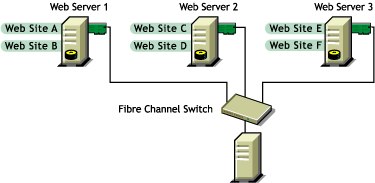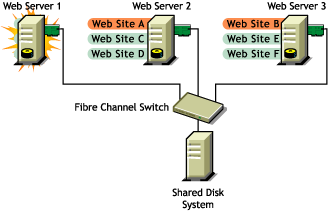1.2 Product Benefits
Novell Cluster Services allows you to configure up to 32 NetWare servers into a high-availability cluster, where resources can be dynamically switched or moved to any server in the cluster. Resources can be configured to automatically switch or be moved in the event of a server failure, or can be moved manually to troubleshoot hardware or balance the workload.
Novell Cluster Services provides high availability from commodity components. Lower costs are obtained through the consolidation of applications and operations onto a cluster. The ability to manage a cluster from a single point of control and to adjust resources to meet changing workload requirements (thus, manually “load balance” the cluster) are also important benefits of Novell Cluster Services.
An equally important benefit of implementing Novell Cluster Services is that you can reduce unplanned service outages and reduce planned outages for software and hardware maintenance and upgrades.
Reasons you would want to implement Novell Cluster Services include:
-
Increased availability
-
Improved performance
-
Low cost of operation
-
Scalability
-
Disaster recovery
-
Data protection
-
Server Consolidation
-
Storage Consolidation
Shared disk fault tolerance can be obtained by implementing RAID on the shared disk subsystem.
An example of the benefits Novell Cluster Services provides can be better understood through the following scenario.
Suppose you have configured a three-server cluster, with a Web server installed on each of the three servers in the cluster. Each of the servers in the cluster hosts two Web sites. All the data, graphics, and Web page content for each Web site is stored on a shared disk subsystem connected to each of the servers in the cluster. The following figure depicts how this setup might look.
Figure 1-1 Three-Server Cluster

During normal cluster operation, each server is in constant communication with the other servers in the cluster and performs periodic polling of all registered resources to detect failure.
Suppose Web Server 1 experiences hardware or software problems and the users depending on Web Server 1 for Internet access, e-mail, and information lose their connections. The following figure shows how resources are moved when Web Server 1 fails.
Figure 1-2 Three-Server Cluster after One Server Fails

Web Site A moves to Web Server 2 and Web Site B moves to Web Server 3. IP addresses and certificates also move to Web Server 2 and Web Server 3.
When you configured the cluster, you decided where the Web sites hosted on each Web server would go should a failure occur. In the previous example, you configured Web Site A to move to Web Server 2 and Web Site B to move to Web Server 3. This way, the workload once handled by Web Server 1 is evenly distributed.
When Web Server 1 failed, Novell Cluster Services software
-
Detected a failure.
-
Remounted the shared data volumes (that were formerly mounted on Web server 1) on Web Server 2 and Web Server 3 as specified.
-
Restarted applications (that were running on Web Server 1) on Web Server 2 and Web Server 3 as specified.
-
Transferred IP addresses to Web Server 2 and Web Server 3 as specified.
In this example, the failover process happened quickly and users regained access to Web site information within seconds, and in most cases, without having to log in again.
Now suppose the problems with Web Server 1 are resolved, and Web Server 1 is returned to a normal operating state. Web Site A and Web Site B will automatically fail back, or be moved back to Web Server 1, and Web Server operation will return back to the way it was before Web Server 1 failed.
Novell Cluster Services also provides resource migration capabilities. You can move applications, Web sites, etc. to other servers in your cluster without waiting for a server to fail.
For example, you could have manually moved Web Site A or Web Site B from Web Server 1 to either of the other servers in the cluster. You might want to do this to upgrade or perform scheduled maintenance on Web Server 1, or just to increase performance or accessibility of the Web sites.